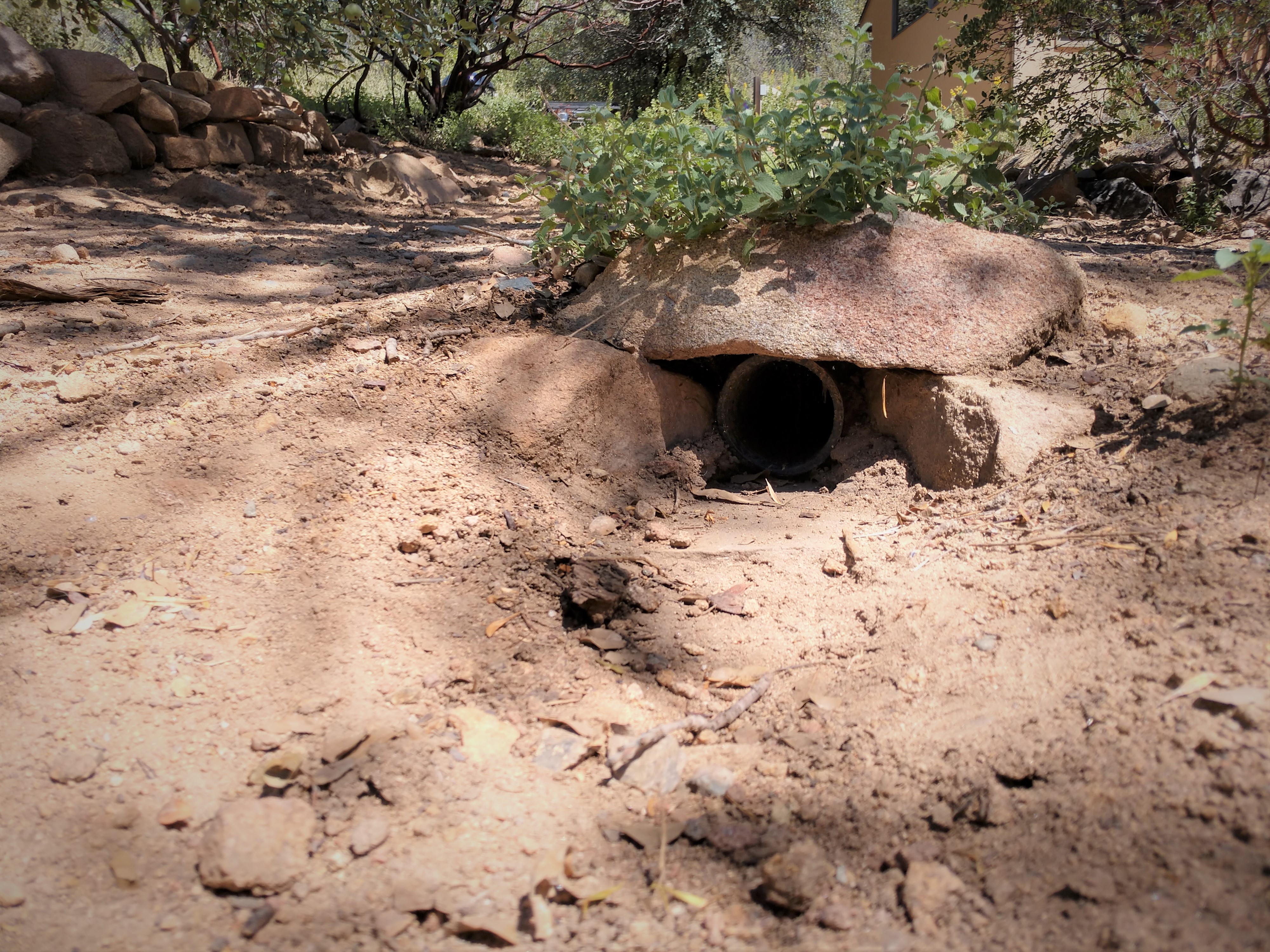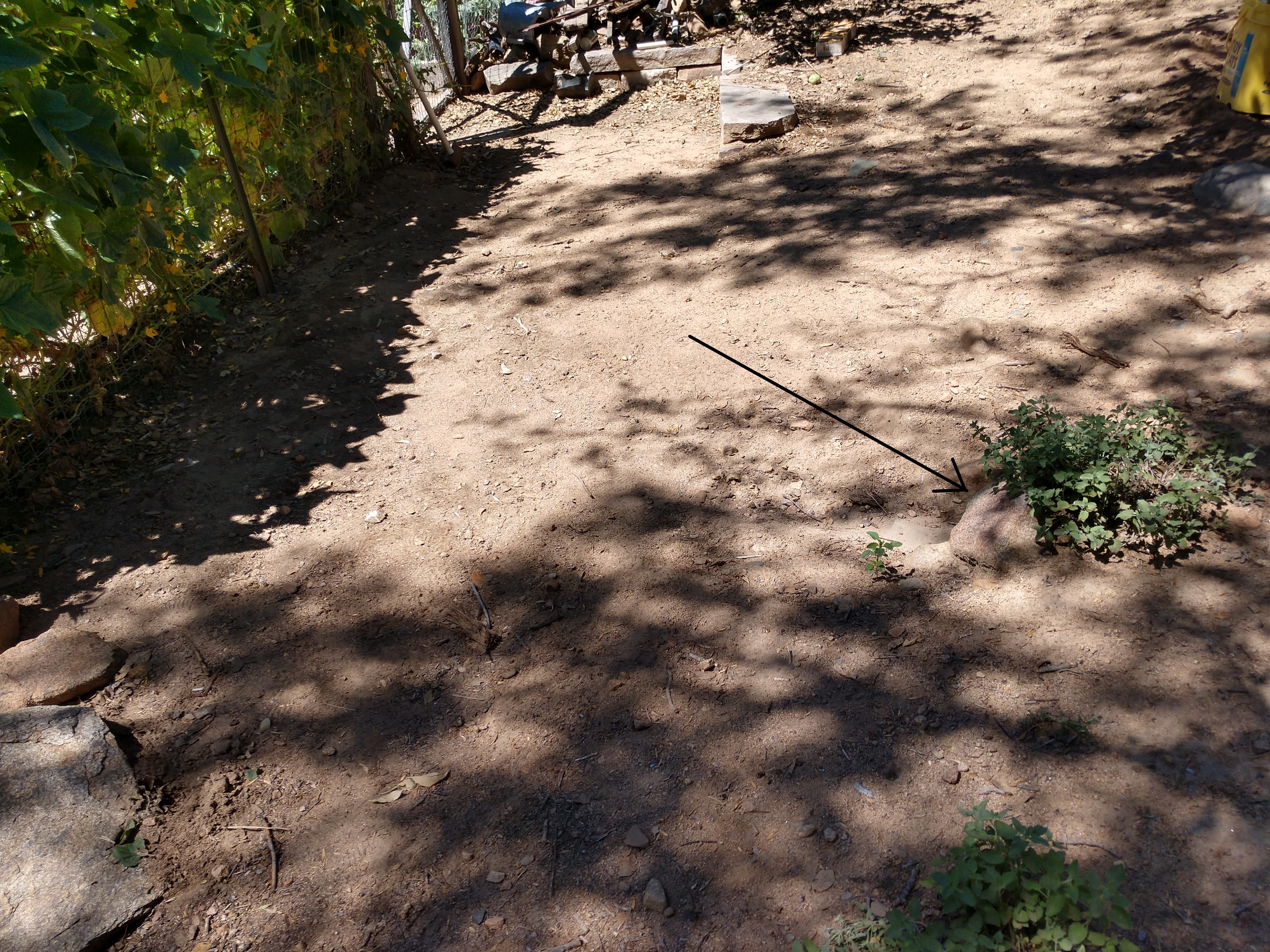 Passive Rainwater Harvesting - September 9, 2020 Jeff Schalau, Agent, Agriculture & Natural Resources University of Arizona Cooperative Extension, Yavapai County We often view topography as a hinderance to gardening and landscaping, but it can also be used to direct the flow of rainwater and snow melt to areas where it will benefit plants and enhance your property’s appearance. Passive rainwater harvesting slows flowing water down and encourages it to soak into the ground. By modifying gradients and building pathways (often called “earthworks”) that catch and direct runoff, this water can be used beneficially, encouraging plant growth, and reducing or replacing the need to irrigate with potable water. Many homeowners are using tanks to harvest and store rainwater. These active rainwater harvesting systems are great but have maintenance needs and can be expensive. If you have one of these systems, you know that you need storage tanks, first flush devices, debris filters, and possibly pumps to distribute water where it needs to be. If you experience freezing temperatures, you also need to winterize your system to prevent damage. I have joined together several downspouts to passively irrigate our vegetable garden. Passive methods avoid much of this complexity and strive to keep the rainwater in the soil where it provides multiple benefits. To do so, we must slow down runoff, spread the water out, and allow it to soak in. Before breaking ground, observe how much and where water currently moves across your property. Start at the top of the “watershed” and design from there watching for opportunities to spread and store water. There are likely multiple options and techniques that can be employed. Mulches enhance the effect by protecting the soil surface from erosion, mitigating annual weeds, limiting direct evaporation from the soil surface, and keeping plant roots cooler. Do not dig woody mulch materials into the soil where it could negatively impact nutrient availability. Where mulch is used, it will need to be replenished every few years as decomposition occurs. Many municipalities and utility companies chip woody green waste and make it available to consumers as mulch. Check with your local transfer station or electricity utility for availability. Also see the July 27, 2011 Backyard Gardener: Using Mulch in the Landscape. As discussed in a recent Backyard Gardener column, trees and shrubs thrive when they develop broad-ranging root systems that utilize greater volumes of soil (August 26, 2020 Backyard Gardener, Tree Irrigation During Drought). Passive rainwater harvesting can enhance water distribution to and among adjacent trees and shrubs. Berms and swales are the primary means to enhance distribution of passive rainwater across broad sloped areas. Before building berms and swales, it may be a good idea to establish level contour lines across the slopes in your landscape. This can be done with wooden stakes, string and a line level that attaches to the string. Other methods can also be used (water level with clear poly tubing or an inexpensive laser level). Once level contour lines are identified, berms can be built from one contour line to the next with soil and rock to deliver water across a slope. Depending on soil drainage, you will need to balance flow rates with the steepness of the slope to move water slowly, but effectively across the area allowing some of it to infiltrate as it goes. It often becomes an iterative process and swales/berms may need to be moved or adjusted. Many landscapes have dry streambeds that take water away from structures and foundations. These can be modified to include check dams that slow water or meanders can be added to better distribute the flow. Terraces placed on slope contours are a more substantial approach to rainwater harvesting. Here, the rainwater can spread across one terrace before it flows to the next lower level. This is a more durable approach often including native stone or landscape blocks. Many landscape professionals are getting tuned into passive rainwater harvesting and for big jobs, you may want to enlist some help. If so, make sure your passive rainwater harvesting goals and expectation are discussed, agreed upon, and documented before work begins. The goal of passive rainwater harvesting is to keep rainwater on your property and allow it to infiltrate where it can benefit landscape plants while not causing issues with structures and other hardscape elements. I have linked many resources below including a short video on using simple tools to use levels in creating contours. You can follow the Backyard Gardener on Twitter – use the link on the BYG website. If you have other gardening questions, email the Master Gardener Help Desk in Prescott (prescottmg@gmail.com) or Camp Verde (verdevalleymg@gmail.com) and be sure to include your name, location, and phone number. Find past Backyard Gardener columns or provide feedback at the Backyard Gardener web site: https://cals.arizona.edu/yavapai/anr/hort/byg/. Images  Downspouts from 1/3 of our house were plumbed to this outlet near the vegetable garden (Photo by Jeff Schalau, University of Arizona).
Downspouts from 1/3 of our house were plumbed to this outlet near the vegetable garden (Photo by Jeff Schalau, University of Arizona). From the outlet in the above photo (see arrow), water flows down into the garden through the gate (Photo by Jeff Schalau, University of Arizona).
From the outlet in the above photo (see arrow), water flows down into the garden through the gate (Photo by Jeff Schalau, University of Arizona). Garden gate showing how the flow from the previous two photos enters the garden and can spread throughout. Monsoon rains of 1/2" provide 2" or more of irrigation to the entire garden (Photo by Jeff Schalau, University of Arizona).
Garden gate showing how the flow from the previous two photos enters the garden and can spread throughout. Monsoon rains of 1/2" provide 2" or more of irrigation to the entire garden (Photo by Jeff Schalau, University of Arizona).Additional Resources Passive Rainwater Harvesting, University of Arizona Cooperative Extension extension.arizona.edu/sites/extension.arizona.edu/files/pubs/az1564.pdf Water Harvesting: Passive Use in the Landscape, eXtension landscape-water-conservation.extension.org/water-harvesting-passive-use-in-the-landscape/ Rainwater Harvesting for Landscape Use, University of Arizona Cooperative Extension wrrc.arizona.edu/sites/wrrc.arizona.edu/files/Harvesting%20Rainwater%20for%20Landscape%20Use.pdf Develop A Water Resources Strategy, LEAF Network - Linking Edible Arizona Forests https://leafnetworkaz.org/Water-Resource-Strategy Rainwater Harvesting for Drylands and Beyond, Volumes 1 & 2, Brad Lancaster www.harvestingrainwater.com/ A very nice video clip from "This Old House" showing some low cost, low tech ways to estimate level on a gradient. A level line against a slope is called a "contour line". If nothing else, you've gotta love the New England accents! |